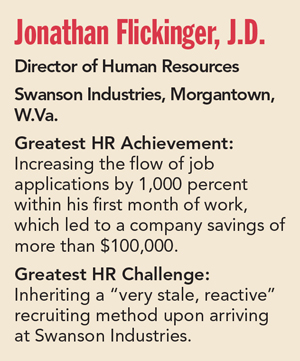This article accompanies Ever Upward.
If you think the world of combat sports has nothing in common with the world of human resources, then you have yet to meet Jonathan Flickinger, HR’s very own “mixed martial generalist.”
As is the case with many others in HR, the path that led Flickinger to the position he held at the time he was selected as one of this year’s HR’s Rising Stars – director of human resources at Swanson Industries – was a winding one.
But unlike most other HR practitioners, his professional journey has already led him from the contemplative cocoon of law school to the controlled chaos of the combat-sports industry and beyond.
It was during his time as an evening-division student at Duquesne University School of Law in Pittsburgh that Flickinger began a letter-writing campaign to “infiltrate” the sports and entertainment industry after graduation, he says.
His efforts ultimately led to a position with StarPR, a Las Vegas-based public-relations firm that works directly with both the Ultimate Fighting Championship and K-1, the world’s largest kickboxing organization.
“Instead of just becoming another cookie-cutter attorney,” he says, “I was working with pro athletes doing PR work, working on a lot of contracts and marketing, too.”
Flickinger says the StarPR job highlighted for him the connection between the two seemingly disparate disciplines of human resources and humans battling each other.
“It was the intersection of my two worlds,” he says. “The sport really revolves around people who are well-versed in a bunch of fields, and I wanted to know the full spectrum of HR disciplines. And what I noticed in the HR industry is that the focus is on becoming specialized in a single discipline.
“But I found that having a more versatile skill set in HR is much more beneficial to being able to tackle any problem,” he adds.
 While he acknowledges that the profession of human resources may not be a combat sport, “if you look at the nature of our labor market and talent pipelines, it is very competitive. You’re always competing against other companies in your space. You want the best talent. That competitive nature is part of it.”
While he acknowledges that the profession of human resources may not be a combat sport, “if you look at the nature of our labor market and talent pipelines, it is very competitive. You’re always competing against other companies in your space. You want the best talent. That competitive nature is part of it.”
So with that aggressive mind-set, Flickinger took on the post of HR manager at Swanson, an engineered-hydraulics firm based in Morgantown, W.Va., that operates in five countries, eight states and three business divisions. (He is no longer with the company.)
Looking back now, he says, it seems natural that the first area he would tackle would be the company’s “stale and reactive” recruitment process.
“It was literally like walking into 1990,” he says of the company’s outdated recruitment function. “It was a dinosaur. We were just advertising in the local newspapers and using expensive search firms to fill positions.”
However, just days after he was hired, “we had a careers page up on our website, we got on Indeed.com and LinkedIn, and we became a proactive, rather than a reactive, employer,” he says.
And within his first two weeks, each job posting was getting 400 to 500 applications, as opposed to the 25 or so before he arrived.
Flickinger’s recruiting reboot saved the company more than $100,000 on search firms and other now-unnecessary costs.
And, in addition to taking ownership of the company’s recruitment process, he also buffed up its employment brand by personally managing its social-media accounts on Twitter and other platforms.
His contributions have not been limited to the transactional side of the ledger, though.
Flickinger also “challenged the decisions of peers and leaders when the HR function and its purpose was not being represented well,” according to Steve Weidenmuller, senior vice president of HR at Swanson Industries and Flickinger’s former supervisor.
Flickinger says that “sometimes you still have that old-school way of thinking with certain people, be it a manager or employee, and you have to really have confidence that you can address any situation.”
To wit, he recalls a recent situation in which an employee performing a job interview “thought it was his role to be hiring manager and make an offer to someone” but didn’t touch base with the HR department about it beforehand.
“[The employee was] above me in the organization, but I didn’t have any problem calling him out on it,” he says. “From that point on, he respected me even more.”
While Flickinger has proven himself to be adept at being a forceful defender of the borders of the human resource function, he’s also become known for his high-touch personality among the company’s diverse, multigenerational workforce that is made up of both union and nonunion workers.
“He builds and leverages relationships to get work done,” says Weidenmuller.
Flickinger also represents “the new breed of HR leadership,” Weidenmuller says, adding that the title of “mixed martial arts-generalist” fit his direct report to a T.
“Considering he uses his multifaceted skill set and background to gain a competitive advantage no matter where he is,” says Weidenmuller, “that’s very similar to the fighters he used to work with on a regular basis.”

